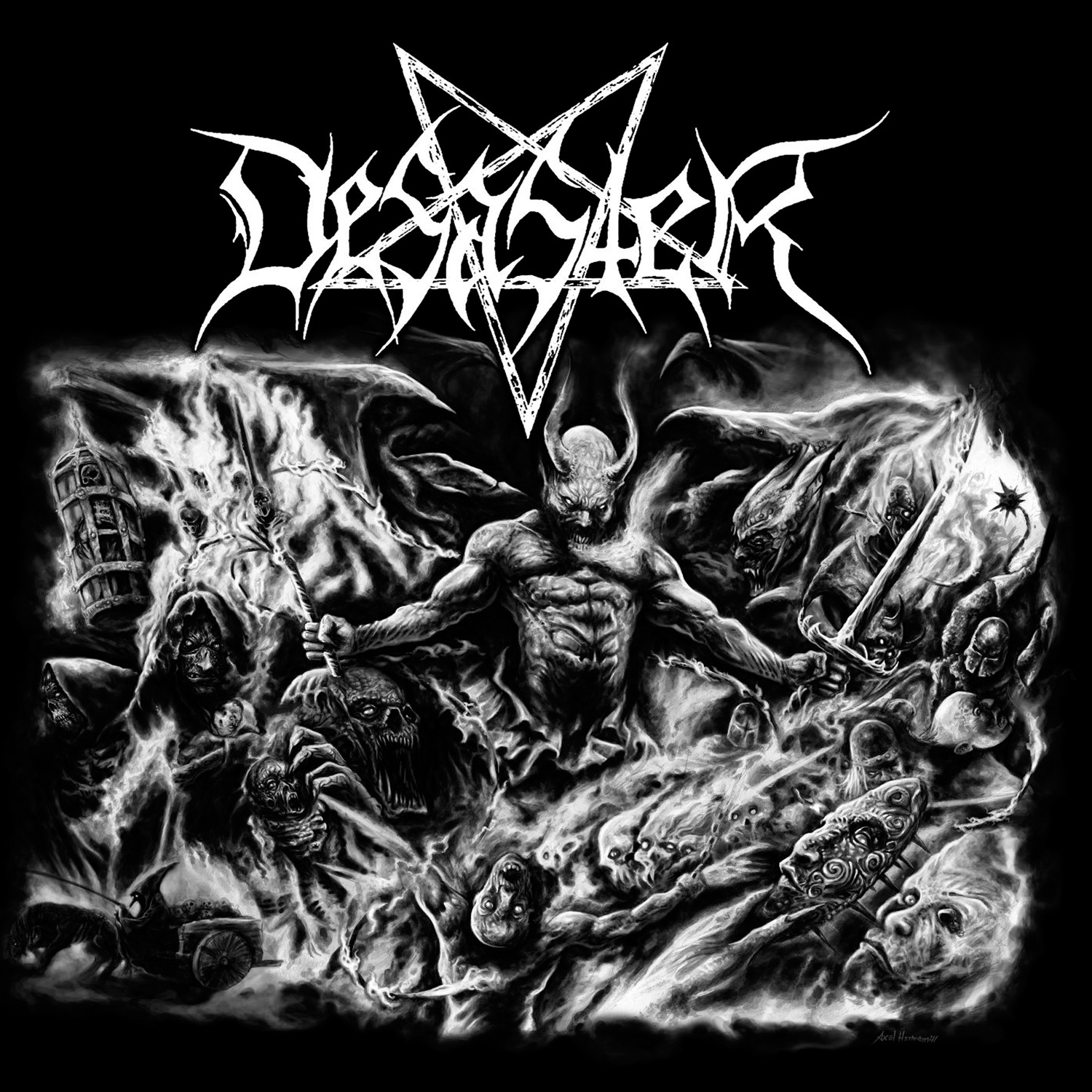
Album Review: Desaster - "The Arts of Destruction"
To call German black metal band Desaster “veteran” is to not be nearly descriptive enough. Desaster, and by extension their iconically idiomatic misspelling, are veterans in the sense that Ray Bourque was a veteran when he finally won the Stanley Cup with Colorado. Desaster has toiled in obscurity, experienced the highs and lows of success and marginalization, the tumult of frequent and varied roster changes, the dedication of valued fans and the prosecution by those who fail to understand, and, in short, has been around the block.
Desaster has been around long enough at this point that it is mostly inappropriate to say that they “sound like band X.” More likely than not and possibly by the proxy of a middleman band that Desaster influenced, “band X” sounds like Desaster.
As such, this new album “The Arts of Destruction” is more than merely another record of throwback black metal. The cover art of this new record is layered deeper than face value; rather than a simple and powerful depiction of a demon, the image can be interpreted as a show of dominance by the band, a grand vision of the musicians screaming “get out of the way!” at the pretenders to their throne.
If there was any lingering doubt that Desaster intends this album to be a strong statement of their virility and continued effort, that doubt is summarily put to rest by the scowling, disdainful laughter of vocalist Sataniac during the opening salvo of the album’s title track. His wicked cackling serves not only to set the table for the band’s title track and the chaos to follow, but seems to carry a spiteful note, as though the band is looking around at the metal landscape and proclaiming “we’re still here, you bastards! You can’t stop us!”
Now, with the introductions out of the way, let’s get down to brass tacks (how much for the ape?) As many bands as there are who have been colored by the music of Desaster, the German band draws inspiration from an artist’s palette of their own. Desaster’s new record is a remarkable achievement for its blending elements of that most bands either overlook, or have inherited through a scrim of distortion from other bands. If confronted on the street to describe the sound of “The Arts of Destruction,” an astute listener would call them “traditional black metal. Not black metal like is represented by those noisy corpse-painted screamers, but a logical extension of black metal as Cronos and Venom envisioned it in 1981 and ’82.”
As such, Desaster is more than just ceaseless pounding and unnecessary noise. “The Arts of Destruction” slyly incorporates elements of both American and crust punk, as well as the basics of thrash and rudimentary blues metal that accompanied Venom’s early releases. “Queens of Sodomy” sounds strikingly similar to Black Flag’s “Thirsty and Miserable,” and I absolutely mean that as a compliment. Meanwhile, “Troops of Heathens, Graves of Saints” would have sounded right at home on any recent Slayer release.
That’s not to say that Desaster can’t be their own band, however. Where “The Arts of Destruction” really shines is in the band’s ability to pull back ever so slightly on the reigns and let the songs breathe a little. “Lacerate (with Rans of Doom)” works much better as a song because the musicians dedicate the song’s middle third to establishing a hook riff to go along with the incessant percussion that flanks it on either side. This same trend applies to the back half of “The Splendour of the Idols,” which becomes, if not versatile, at least variable in speed, design and intensity.
Not as steeped in Norse folklore as many contemporary black metal bands are, no less an authority than Wikipedia cuts straight to the bone and says of Desaster “Their lyrical themes involve war, hate and satanism.” There’s plenty of anger to go around, but it’s truly the musicianship that carries the day for “The Arts of Destruction” and makes it worth investing in. A lot of credit goes to Tormentor on drums, who could have taken the easy way out and simply pounded his way through this album, but instead knows when to go and knows when to hold up, allowing the guitars to dominate the music’s character when necessary.
A strong, artfully constructed long piece like “Possessed and Defiled” would have been ruined in the percussion had been used as the base and not the accent of the piece. As it is, this song comes in three acts and is perhaps the album’s jewel, built on a foundation of strong riffs and fast but not overbearing pacing.
The only thing to watch out for with Desaster’s new effort is the guitar tone, which is tuned to be as crunchy as possible, but comes off as almost brittle in a few spots. A tune like “At Hell’s Horizon” could have improved by a weightier guitar sound to counterbalance the song’s distracting second-to-second fury.
Desaster’s “The Arts of Destruction” is a throwback to a time before black metal evolved into an ear-splitting drone, and remembers its roots with high-quality riffs, just a hint of blues-based hook and an impeccable galloping pace. Find some time for this album if you’re a fan of crust punk, original European speed metal or old-school thrash. Hell, even if you’re not into those three, listen to this album anyway. There’s a lot to like.

